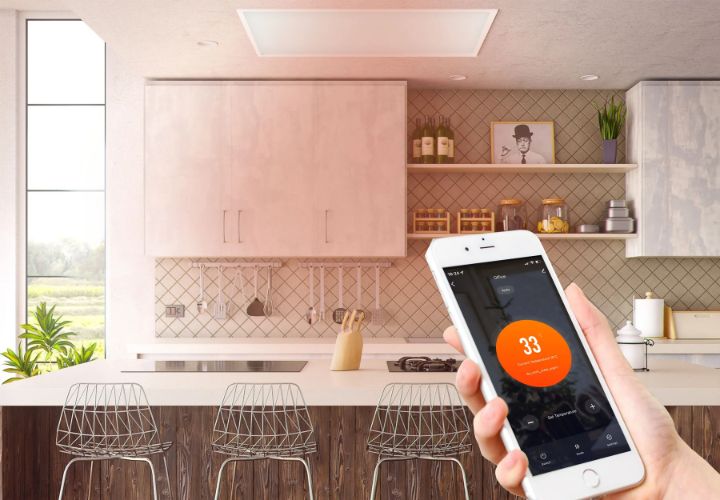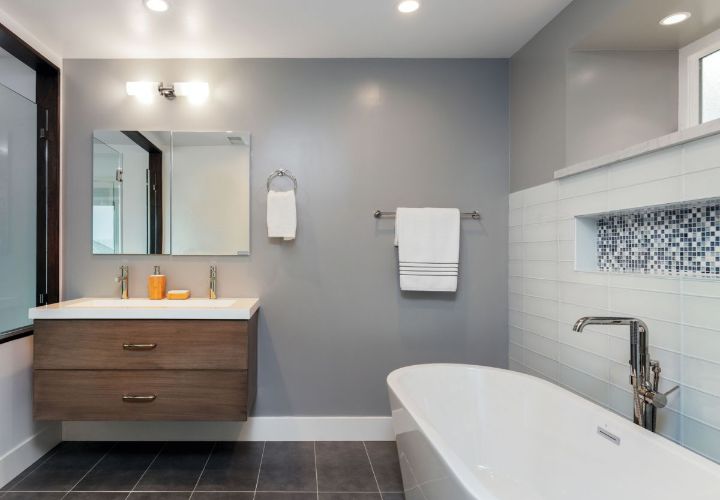Key Notes
- Electric radiant panels convert electrical energy into infrared radiation, a safe form of heat that can be felt but doesn’t harm the skin.
- Unlike traditional heating systems, radiant heating panels heat objects through conduction, producing efficient and comfortable heating.
- The operating cost of radiant heat panels depends on their wattage and can be calculated by multiplying the kilowatt-hours (kWh) consumption by the electricity cost per kWh.
- Factors like square footage, ceiling height, windows, and insulation determine the size of the radiant heat panel needed for a space.
How do Radiant Panel Heaters Work?
With their ability to provide efficient and comfortable warmth through methods like infrared radiation or heated fluids, radiant panels are gaining popularity among homeowners and businesses seeking energy-efficient and effective heating systems. But what are radiant panels, and how do they work?
Electric Radiant Heat Panels
Electric heat panels, also known as infrared radiant heat panels, convert electrical energy into infrared radiation. Infrared radiation is part of the electromagnetic wave spectrum. It has a wavelength longer than visible light but shorter than radio waves and microwaves.
Infrared radiation can be seen as heat or thermal radiation. Infrared radiation is the direct transfer of energy from one thing to another without warming up the air. Like sunlight, it’ll warm you up if you stand near it. But unlike sunlight, infrared doesn’t cause any damage to your skin.
Carbon Fiber Radiant Panels
Carbon fiber panel heaters use electrically conductive carbon fibers to generate radiant heat. They emit infrared radiation that warms objects and people in the room. Carbon fiber radiant panel heaters provide quick heating response and are known for their energy efficiency.
Convection Radiant Panels
Convection radiant panels are a variant of radiant heat panels that incorporate convection heating technology. These panels combine the benefits of radiant heat with the additional feature of convective airflow.
As the panels emit radiant heat, they also create a gentle air circulation within the yoga studio. This airflow helps to distribute the warmth more effectively, ensuring an even temperature throughout the space.
Radiant Heat Panels Operating cost
How much electricity a radiant heat panel uses depends on the wattage of the panel. You can easily find the consumption by dividing the total wattage by 1000. Once you have the consumption, you simply multiple the kWh consumed by the kWh cost in your area.
For example, a 400W heat panel consumes 0.4 kWh of electricity per hour (400W/1000). Using the national average electricity cost of $0.14/kWh, a 400W radiant heating panel costs just over $0.05 per hour (0.4 kWh * $0.14/kWh) to operate.
| Radiant Heat Panel Type | Upfront Cost Range | Running Cost Estimate per Day |
|---|---|---|
| Electric Radiant Heat Panels | $100 – $1,899 | $1.20 |
| Convection Radiant Panels | $100 – $300 | $1.08 |
| Carbon Fiber Radiant Panels | $200 – $500 | $0.216 |
Electric Radiant Heat Panels cost:

Electric panels use electricity to generate heat, providing spot heating or targeted warmth in specific areas. They offer control flexibility, making them convenient and energy-efficient options for creating comfortable environments.
Upfront Cost:
The upfront cost of electric radiant heat panels can vary depending on the brand, size, and quality. The average cost can range from $100 to $1,899 per panel.
Running Cost:
The running cost depends on the panel’s wattage and the local electricity rates. Generally, electric panels have moderate running costs compared to other heating systems.
The estimated Running Cost = (1000 / 1000) * 0.15 * 8 = $1.20 per day
Convection Radiant Panels cost

Convection panels, also known as convection heaters or convection radiators, are heating devices that work through the process of convection. They use natural air circulation to heat a room or space.
Upfront Cost:
On average, you can expect to pay between $100 and $300 per panel. However, prices may vary significantly based on the quality and efficiency of the unit.
Running Cost:
Estimated running costs = 1.5 kW x 6 hours x $0.12/kWh = $1.08 per day
It’s worth noting that convection panels can be more energy-efficient than traditional radiators or baseboard heaters, as they distribute heat more evenly. This improved efficiency can potentially result in lower running costs compared to other heating systems.
Carbon Fiber Radiant Heating cost

Carbon fiber radiant panels are a type of heating panel that utilize carbon fiber elements to produce heat. These panels work based on the principle of infrared radiant heating, similar to electric radiant heat panels.
Upfront Cost:
On average, you can expect to pay between $200 and $500 per panel. However, prices may vary based on the quality and efficiency of the specific model.
Installation costs for carbon fiber radiant panels are usually minimal. These panels are typically designed to be mounted on walls or ceilings, and the installation process is relatively straightforward. It generally involves securing the panels in place and connecting them to a power source. If you choose to hire a professional for installation, additional costs may apply.
Running Cost:
Running Cost = 0.3 kW x 6 hours x $0.12/kWh = $0.216 per day
In most cases, radiant heat panels do not need to run 24/7 to keep the space warm and comfortable. You may find that the panels only need to run a few hours a day to maintain your desired temperature.
Choosing The Best Radiant Heat Panels
Choosing the best radiant heat panels doesn’t have to be a daunting task. With a few simple considerations, you can find the perfect radiant heat panel to keep you warm and comfortable.
We’ve written a comprehensive guide exploring the best-infrared heating panels on the market and have identified Herschel Inspire Picture Radiant Heat Panel as the best overall. This panel’s complimentary and versatile design makes it perfect for any room in the property, and its heating element is energy efficient and allows for connection to the MD2 thermostat to allow for ease of control.
Heating Capacity:
Determine the heating capacity required for your room. Consider the size, insulation, and ceiling height of the space you want to heat. This will help you select a panel with the appropriate wattage to warm the area efficiently.
Energy Efficiency:
Look for radiant heat panels with high energy efficiency ratings. Energy-efficient models can help reduce your heating costs and have a smaller impact on the environment. Check for energy certifications and ratings such as Energy Star to ensure the panel meets efficiency standards.
Safety Features:
Prioritize safety features like overheat protection and tip-over switches. These features automatically shut off the panel in case of overheating or accidental tipping, ensuring your safety and preventing potential accidents.
Installation and Design:
Consider the installation requirements and design of the panel. Look for panels that are easy to install, whether they require mounting on walls or ceilings. Additionally, choose a design that complements your interior aesthetics.
One such panel that is designed for aesthetics in mind is the Herschel Mirror Radiant Heat Panel which looks excellent in in bedrooms, bathrooms, and wetrooms. It’s perfect in these rooms because it’s designed not to fog up when a room has a build-up of steam, so you avoid mould and unnecessary condensation.
Are Radiant Heating Panels Efficient?
Radiant heat panels are becoming increasingly popular because they provide energy efficiency and comfort at the same time.
A radiant panel heats objects through conduction rather than convection. This means that spaces and things are not heated by circulating hot air. Instead, radiant heating panels transfer the heat directly to mass – like walls, floors, furniture, and you!
These objects absorb the heat and gently radiate it back into the space. As a result, radiant heating panels are much more efficient than traditional heating systems. Let’s explore the efficiency of different radiant heat panels.
Electric Radiant Panels:
Heat Distribution:
Electric radiant heat panels emit infrared radiation that directly heats objects and people in the room. This focused heating allows for quick and efficient warmth.
Energy Control:
These panels offer control flexibility, allowing you to adjust the heat output based on your needs. You can easily turn them on or off, which helps minimize energy wastage.
Efficiency Considerations:
Electric radiant heat panels can be efficient for localized heating. However, their efficiency may be influenced by factors such as insulation, room size, and heat loss through drafts or poorly insulated walls.
Convection Radiant Panels:
Heat Distribution:
Convection panels provide more even heat distribution throughout the room. As warm air rises, it circulates and gradually fills the space. This helps to prevent localized hot or cold spots.
Heat Retention:
Convection panels tend to have better heat retention because the warmed air lingers in the room. Once the room reaches the desired temperature, the panel can cycle on and off to maintain it, reducing energy consumption.
Efficiency Considerations:
Convection panels can be more energy-efficient than traditional radiators or baseboard heaters, as they distribute heat more evenly. However, their efficiency may depend on factors such as room size, insulation, and air circulation in the space.
Carbon Fiber Radiant Panels:
Quick and Targeted Heating:
Carbon fiber radiant panels emit infrared radiation that directly heats objects and people in the room. This results in quick and comfortable warmth, especially in targeted areas.
Energy Efficiency:
Carbon fiber panels typically have lower power consumption compared to other electric heating systems. They offer efficient and focused heating, reducing energy waste by directly heating objects and occupants.
Efficiency Considerations:
The efficiency of carbon fiber radiant panels can be influenced by factors such as insulation, room size, and personal comfort preferences. They work well for spot heating and can be more energy-efficient in maintaining comfortable temperatures.
What Size Radiant Heat Panel Do I Need?
The first step to determine what size radiant heat panel you need is to determine the square footage of the space.
With this in hand, select a radiant heat panel that provides enough coverage for the area. The higher the wattage, the larger space the radiant heater can heat. For larger spaces, you might find that you’ll need more than one radiant heating panel.
Keep in mind that radiant heating panels have a “general” square foot heating range and that factors such as ceiling heights, windows, and insulation can have an impact on this number.
For example, if you have an older home with leaky windows and little insulation, you’ll want to increase the size of the radiant heat panels or the number of heaters.
The team at Green Wave Distribution is always available for free system sizing consultations so don’t hesitate to reach out.
Why Choose a Radiant Heating Panel from Green Wave Distribution?
Green Wave Distribution only carries the highest quality radiant heat panels. Our team of heating system designers are experts in sizing and selecting the right radiant heat panels for your home or commercial property. You don’t have to take our word for it, just ask one of the hundreds of satisfied customers throughout the USA!







